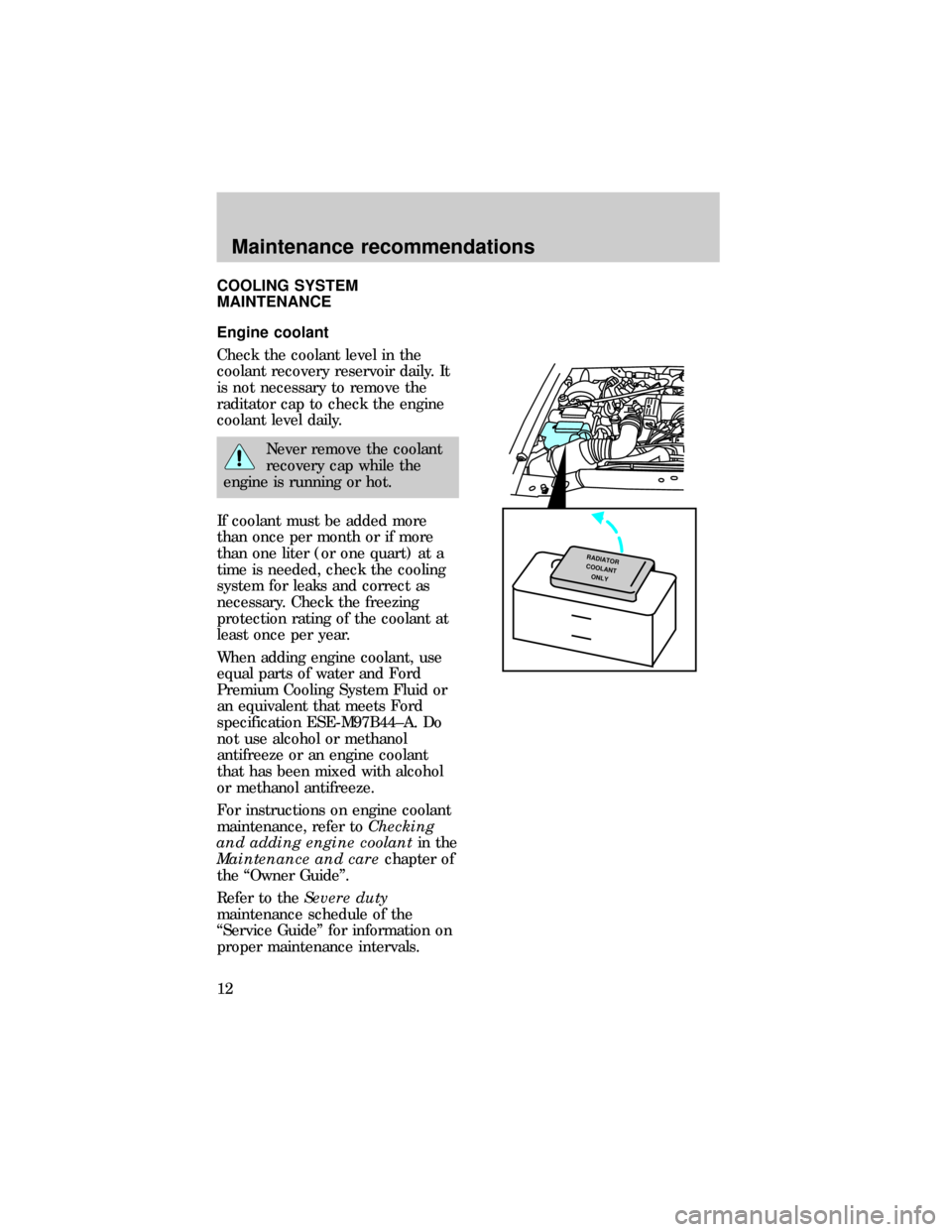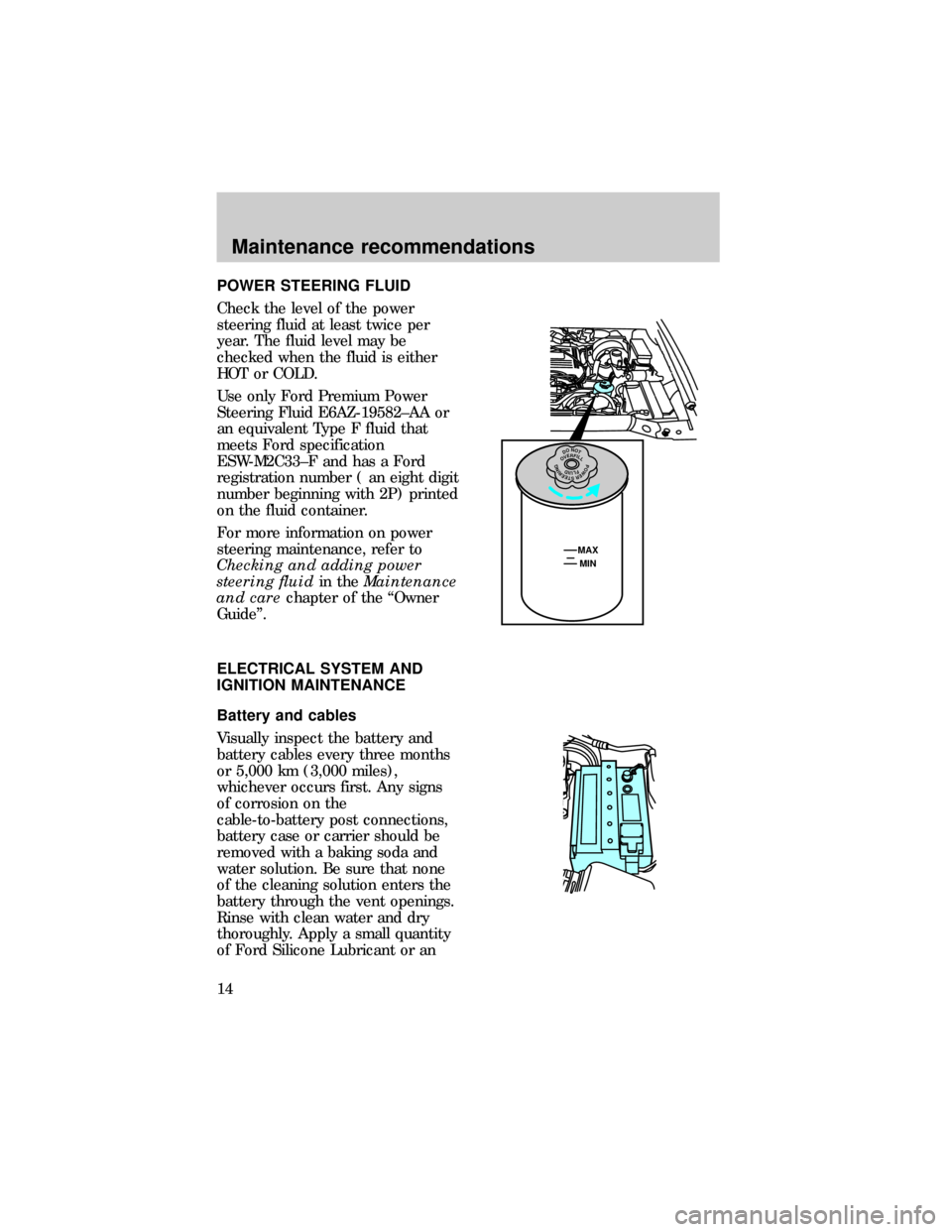Page 9 of 28
Manual transmission and
differential fluid (if equipped)
Clean and remove the filler plug.
The fluid level should be up to the
bottom of the filler plug hole. For
more information on differential
fluid maintenance, refer to
Checking and adding differential
fluidin theMaintenance and
carechapter of the ªOwner
Guideº.
Clutch fluid (if equipped)
The clutch fluid for your vehicle is
self-adjusting and should not
require any routine service.
During normal operation, the fluid
level in the clutch fluid reservoir
will slowly rise. If the fluid level
drops, add fluid to maintain the
level at the step in the reservoir
body.
If it is necessary to remove the
fluid reservoir cap, thoroughly
clean the cap before removal to
prevent contaminants from
entering the reservoir. Remove the
internal diaphragm and add only
Ford High Performance DOT 3
Brake Fluid C6AZ-19542±AA or an
equivalent DOT 3 fluid that meets
Ford specification ESA-M6C25±A.
Maintenance recommendations
9
Page 10 of 28
ENGINE MAINTENANCE
Engine oil recommendations
Ford recommends that you use
Motorcraft oil or an equivalent oil
meeting Ford specification
ESE-M2C153±E andcertified by
the American Petroleum
Institute for gasoline
engines.Look for the American
Petroleum Institutes certification
mark.
Do not use:
²non-detergant oils
²oils labeled API SA, SB, SC, SD,
SE or SF
²oil additives, oil treatments or
engine treatments
SAE 5W-30 oil is preferred for all
temperatures. SAE 10W-30 is
acceptable for moderate to hot
temperatures.
Check and add engine oil
according to the intervals listed in
the ªService Guideº. For
information on engine oil
maintenance, refer toChecking
and adding engine oilin the
Maintenance and carechapter of
the ªOwner Guideº.
MAX MIN
Maintenance recommendations
10
Page 11 of 28
Oil change interval
The engine oil should be changed
every three months or 5,000 km
(3,000 miles), whichever occurs
first.
If the engine oil is not changed as
recommended, inaccurate oil
readings and engine damage may
occur.
Oil filter change
Use only an approved engine oil
filter such as the Motorcraft Long
Life type or an equivalent filter
meeting Ford specification
ES-E4EE-6714AA. Install a new oil
filter at each oil change.
Fuel filter
To prolong the life of the fuel
pump and ensure dependable fuel
system performance, the fuel filter
should be changed every 96,000
km (60,000 miles). This operation
is not required, but is
recommended for California
certified vehicles.
Maintenance recommendations
11
Page 12 of 28

COOLING SYSTEM
MAINTENANCE
Engine coolant
Check the coolant level in the
coolant recovery reservoir daily. It
is not necessary to remove the
raditator cap to check the engine
coolant level daily.
Never remove the coolant
recovery cap while the
engine is running or hot.
If coolant must be added more
than once per month or if more
than one liter (or one quart) at a
time is needed, check the cooling
system for leaks and correct as
necessary. Check the freezing
protection rating of the coolant at
least once per year.
When adding engine coolant, use
equal parts of water and Ford
Premium Cooling System Fluid or
an equivalent that meets Ford
specification ESE-M97B44±A. Do
not use alcohol or methanol
antifreeze or an engine coolant
that has been mixed with alcohol
or methanol antifreeze.
For instructions on engine coolant
maintenance, refer toChecking
and adding engine coolantin the
Maintenance and carechapter of
the ªOwner Guideº.
Refer to theSevere duty
maintenance schedule of the
ªService Guideº for information on
proper maintenance intervals.
RADIATOR
COOLANT
ONLY
Maintenance recommendations
12
Page 13 of 28
Maintaining the system
Inspect all cooling system and
heater hoses for deterioration,
leaks and loose clamps. Service
and replace as necessary.
Cooling slots are provided in the
front grille. Do not block airflow by
placing any objects in front or
behind these slots.
Check air flow paths of the
radiator for any foreign material.
Clean these areas as necessary to
maintain maximum cooling
efficiency. When cleaning the
radiator, always clean from the
engine side of the engine
compartment to ensure that
foreign material is not jammed into
the radiator fins.
Maintenance recommendations
13
Page 14 of 28

POWER STEERING FLUID
Check the level of the power
steering fluid at least twice per
year. The fluid level may be
checked when the fluid is either
HOT or COLD.
Use only Ford Premium Power
Steering Fluid E6AZ-19582±AA or
an equivalent Type F fluid that
meets Ford specification
ESW-M2C33±F and has a Ford
registration number ( an eight digit
number beginning with 2P) printed
on the fluid container.
For more information on power
steering maintenance, refer to
Checking and adding power
steering fluidin theMaintenance
and carechapter of the ªOwner
Guideº.
ELECTRICAL SYSTEM AND
IGNITION MAINTENANCE
Battery and cables
Visually inspect the battery and
battery cables every three months
or 5,000 km (3,000 miles),
whichever occurs first. Any signs
of corrosion on the
cable-to-battery post connections,
battery case or carrier should be
removed with a baking soda and
water solution. Be sure that none
of the cleaning solution enters the
battery through the vent openings.
Rinse with clean water and dry
thoroughly. Apply a small quantity
of Ford Silicone Lubricant or an
MAX
MIN
DONOTOVERFILLPOWERSTEERINGFLUID
Maintenance recommendations
14
Page 15 of 28

equivalent that meets Ford
specification ESR-M13P4±A to the
terminal surfaces to help prevent
corrosion from forming.
Check the tightness of the cables
to the battery post by hand. It may
be necessary to tighten the clamp
with a suitable wrench.
Ignition system
Visually inspect the plug wires and
ignition coil pack. Any oily dirt
should be removed and the area
cleaned with a damp cloth. Ensure
that all high voltage wires are
firmly attached to the coil pack
and that the other ends are firmly
seated over each spark plug.
Other electrical systems
Wiring, lighting and aftermarket
electrical equipment should be
checked monthly for proper
routing, deterioration or chafing on
other components.
UNDER VEHICLE
MAINTENANCE
Catalytic converters
During normal engine operation,
the catalytic converter surface
temperature can reach up to 816ÉC
(1500ÉF). To avoid injury, ensure
that the converter has cooled
before attempting maintenance.
Ford recommends that an under
vehicle inspection be performed at
Severe Dutyintervals listed in the
ªService Guideº. With the vehicle
Maintenance recommendations
15
Page 16 of 28
supported on a jack or jack stands,
inspect the converter and exhaust
system. Be sure that no foreign
materials are caught in the exhaust
system shielding. Any underbody
sealant or foreign material should
be removed and all possible
contaminants cleaned off of the
shell surfaces.
Visual inspections
Inspect the radiator, engine,
transmission and power steering
for fluid leaks and deterioration
every 24,000 km (15,000 miles) or
three months, whichever comes
first. Any leakage should be
corrected immediately. It is normal
for minor seepage to occur at
gasketed surfaces.
Check the routing of the
speedometer cable and cable
housing. Be sure that it flows
smoothly over its entire area
(routed away from the exhaust
system components) and is free of
kinks or crushed areas.
Maintenance recommendations
16